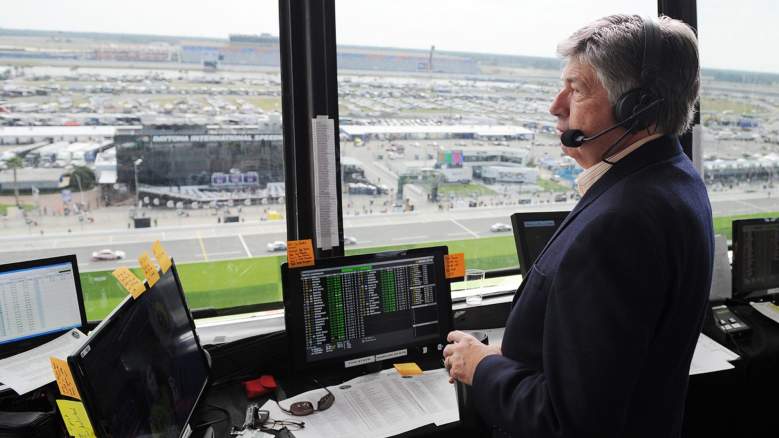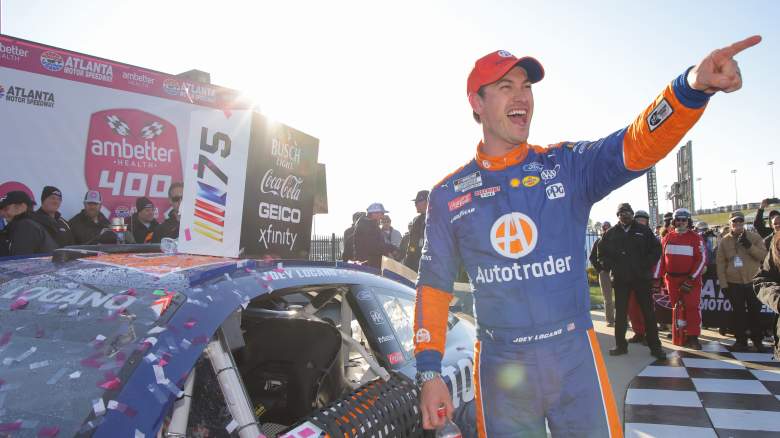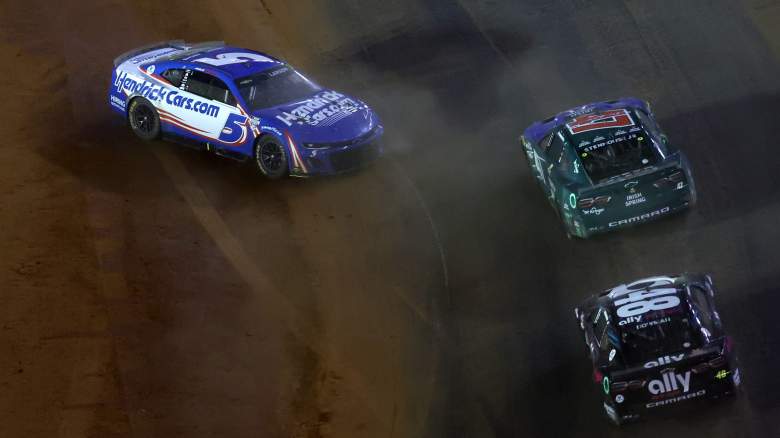
The 2023 NASCAR season has seen FOX Sports using technology to provide unique updates about the drivers’ heart rates, the progress of stages, and the exact moment that the yellow lights turn on. The purpose of these new additions is simple — to tell a better story to the fans.
FOX Sports is only nine events — eight points-paying — into the 2023 schedule, but the broadcaster has generated conversations with some subtle changes for viewers. Chief among them is the addition of a bar graph at the top of the screen, which shows the race separated into three stages.
There are yellow marks indicating the number of cautions and when they occurred, and there are green sections showing how long the race has been progressing without breaks. This helps viewers have a better understanding of when the cautions took place and how old the tires may be at pivotal parts of the race.
“We had a seminar in early January, and I had been working for about a year on something so that the casual fan doesn’t have to do the math of, ‘Okay, how long is Stage 1? How long is Stage 2? Where are we? How do we show graphically where we are in the race?'” longtime broadcaster Mike Joy said during a pre-Bristol interview with Heavy.
“Like in baseball, if you tune into FOX Baseball, the first thing you see up in the corner of the screen is that little diamond with men on base and the score in the FOX Box and how many outs there are. And you know where you are in the game instantly. I said, ‘How do we do that for racing?’ And several of us talked it through, and we came up with this box race tracker, which is a bar graph broken into the stages with green and yellow and so forth.
“Our graphics guys took that — I left them with a sketch in January, early January in discussion — and by the second race of the season, they had a working model. And we kind of gave it a soft open and tried it. Third and fourth race, we needed to tweak it, change a few things, and now I can’t imagine doing a race without it.”
This graph provides extra context for fans that have been watching NASCAR for years. It also serves as a way to help new viewers learn more about the sport and the format used each week.
The goal is to build a larger NASCAR audience and welcome newcomers into the world of stock car racing. This is made easier by providing clear information.
“I talked to my kids who grew up around the sport but are really stick and ball guys — and they both work in TV,” said Artie Kempner, coordinating director, FOX Sports. “And I asked them, ‘Okay, what would make your friends interested in NASCAR?’
“We’ve got to find ways to do that because the world is becoming a niche, and we need to grow our niche all the time. And technology can really help you do that at times if it’s used properly.”
A New Perspective for NASCAR Fans

GettyChris Myers (left) & Clint Bowyer (right) speak with Ryan Blaney.
The new bar graph is only one of the ways that FOX Sports uses to educate fans. The broadcaster uses in-game radio chatter to add context to situations on the track and show the range of emotions experienced by the teams each week.
Another piece of technology incorporated during the 2023 season is the driver’s eye camera. This small lens sits in the padding of the helmet and provides a first-person look at the race while replacing the old visor camera that was used in previous seasons.
Obviously, In-car cameras are nothing new. They have been a part of the sport for a considerable amount of time. They have just progressed to a point where the fans and viewers can see exactly the level of difficulty involved in being a NASCAR Cup Series driver.
“FOX really prides itself — whether it’s [Mike Davies, SVP, Field and Technical Operations] or [President of Operations] Brad Zager — in getting us these technical resources,” Kempner said. “But then it’s our job — to Mike’s point — to engage with the viewers and get them more intimately involved with what they’re seeing.
“So when you watch those hands move right through the driver’s eye or from the driver shot, right, you can kind of feel it. It’s a lot different than just talking about it.”
“Our job is like a three-legged stool,” Joy said. “And the legs are: inform, educate, and entertain. There are times Artie will throw up some of the specialty shots and things, but we’ll just watch along with the viewer because often it’s not planned. Often, Clint or whoever the guest panelist is will react to something from one of those shots, and it leads us into a different kind of discussion.
“I’ll tell you, sometimes we just get lucky. Now, you make your own luck, and Artie just happened to be on Denny Hamlin’s onboard camera when he sent JJ Yeley around and into the Turn 1 wall [at Richmond]. You rode right along with him, you were there, you were in the car. I mean, that’s lightning in a bottle.”
The Heart Rate Straps Add Another Level of Detail

GettyJoey Logano celebrates a win at Atlanta Motor Speedway.
As Joy explained, educating fans is an integral part of the broadcast, and it is something that he focuses on each time he’s in the booth. This has been made more possible in recent seasons with the implementation of heart rate data.
NBC Sports worked out a deal with WHOOP during the 2021 season, and it began tracking the heart rates of Xfinity Series and Cup Series drivers who were willing to wear the straps during races. This deal continued into the 2022 season.
Meanwhile, FOX Sports began gathering this heart rate data and adding it to the broadcasts, dating back to the 2021 Daytona 500. It was not a regular part of the broadcast, but there have been times when this information appeared below the ticker. It showed how a specific driver’s heart rate increased as he prepared for a restart or during an intense sequence of events.
“It’s just another tool to try to help explain to people who think this is easy and think they could get off their couch and jump in a car and do it,” Joy said. “No, you need to be an elite athlete to perform at a very high rate — not just heart rate but a high rate of attention and accomplishment — for a very long period of time.
“Football players, what’s the average play in football? Six seconds, seven seconds. It’s not like this at all. And it’s just so that’s another tool to help tell the story. Artie puts it in a lot on the onboard when we go to an onboard of somebody that’s wearing it. That’s great. We don’t always refer to it, but we will from time to time.”
“It’s one of those deals that [Producer] Pam Miller has been working on for like seven years,” Kempner said. “To us, it makes them human, and that is the biggest challenge that we have — and Mike alluded to it earlier — we need to humanize these guys, right. We need people to understand they’re real people. They’re not driving machines.”
Tracking heart rate data is nothing out of the ordinary for the drivers themselves. Ricky Stenhouse Jr. uses a WHOOP strap, as do many others. William Byron uses the data from his Apple Watch to see how he responds to certain situations on the track. He can then share this with his trainer to see where he needs to make improvements throughout the season.
“I think, for me, it’s kind of more about how quickly I recover from the high heart rate,” Byron told Heavy before the Bristol race weekend. “Like my heart rate usually kind of operates around 150 to 170. I would say 170 would be pretty high for me. Like on road courses and some short tracks, it’ll be higher, but I would say kind of living in that 150 to 170 range is normal for me.”
Byron has this information at his disposal, but the addition of heart rate data during broadcasts adds extra details for the viewers at home. With this information now front and center, the fans can see the amount of effort being put in by their favorite drivers. If they track their own heart rate during races, they can also see exactly how they compare to high-level athletes.
“I think it’s really educational,” Byron continued. “I think back 10 years ago — five to 10 years ago — there was a big question of whether NASCAR drivers were athletes. I think there wasn’t at the time, there weren’t a lot of ways to verify that. No driver could really explain the amount of stress and how high the heart rate is inside the race car.
“So it’s nice now that we have information out there that shows how hard we’re working. And yeah, it’s a different muscle group than a runner or football player, but it still is definitely a sport. It’s still not something you take lightly and hop in the car without hydrating or having the right processes.”
The Technical Expertise Made Some Changes Possible

GettyNASCAR drivers see their heart rate data spike during on-track incidents.
Putting together these changes is not a simple matter. There have to be hard discussions about what is crucial to the broadcast and what can be left by the wayside.
As Kempner said, one of his favorite phrases is “Don’t fall in love with your own s***.” The FOX Sports team has to be able to make hard choices about what to keep while pursuing a better broadcast.
The other hurdle that the broadcaster must overcome is putting everything together. It’s one thing to sketch out a plan on a piece of paper and say that it would be nice to have some extra graphical details. It’s another thing entirely to put it all together and make it look good. Though FOX Sports has a capable group that can deliver on very short notice.
“We were sitting in our production trailer having a meeting one race morning, two weeks ago,” Joy said. “We’re talking about overtime, when does it end and what happens and, ‘Okay, hopefully, we got a shot of the leader when the light comes on to have an idea.’
“And we all just kind of… the light bulb went off at once like, ‘Well, basketball, football have the clock in the lower part of the screen. Why don’t we have a live shot of one of the caution lights?’ So it was just an aha moment. Artie runs out of the trailer. Now, this was nine in the morning, and we go on the air at one o’clock. Our technical crew had it all done and had a way to incorporate it.”
“This team takes resources and turns them from toys into tools,” Kempner added. “And that’s your job. Because it’s just a toy when you get it at first, and then you kind of grind away to figure out how to make it a tool.
“And I’ll tell you that we really have worked over these years — and really this year — we’ve worked really, really hard on just dialing in stuff that makes sense for the viewer and creating more touch points of engagement. Because that’s what we have to do. Like Mike, said we’ve got to keep people interested. That remote control — if the race seems like it’s boring, we’ve got to figure out a way to make it feel more exciting.”




Comments
FOX Sports Educates NASCAR Fans With Technology Updates